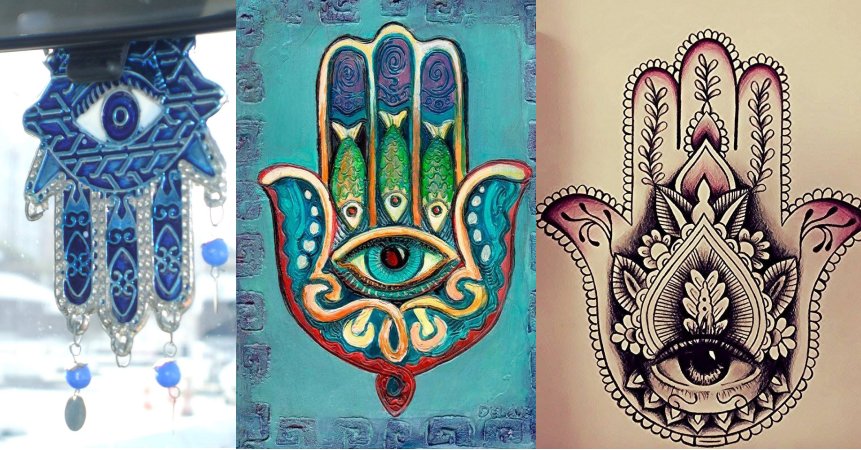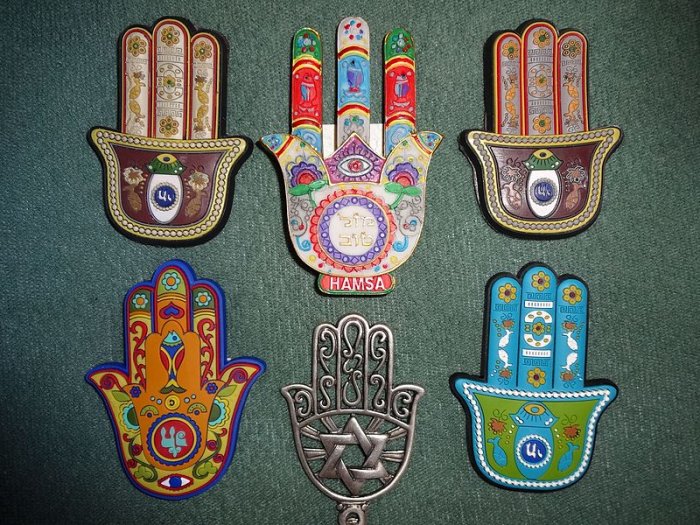Ancient Symbol Hamsa: It’s Meaning And History Explained
Ellen Lloyd - AncientPages.com - Hamsa is an ancient, powerful symbol that is often carried as an amulet to invoke the hand of God, or to counteract the Evil Eye. Tracing the roots of this ancient symbol is not easy because Jewish, Christian, and Muslim scholars cannot agree on the interpretation of Hamsa.
Depicted as an eye embedded in the palm of an open hand, the Hamsa symbol has had numerous other names throughout the ages. Some scholars think the symbol is of Pagan origin and was later adopted by other religions. It’s possible the Hamsa symbol originates from Mesopotamia, ancient Egypt, or Cartage, where a Punic and Phoenician goddess Tanit was worshipped.
Hamsa Symbol Protects From Harm Caused By The Evil Eye
Hamsa is a universal protective sign and we encounter it in faiths. It is believed the symbol brings its owner happiness, luck, health, and good fortune. Hamsa offers protection from harm caused by the evil eye. As previously mentioned in Ancient Pages, there is an ancient, superstitious, and almost universal belief that certain people possess the supernatural power to cause disaster, illness, calamity and even death.
They have the ability to do it with a gaze or stare that gives an unpleasant emotion. The evil eye is widely feared in many parts of the world.
This is why the Hamsa symbol can be found today throughout the Middle East. Wearing charms or amulets is technically against Qu’ran law, but in Islamic countries, one can often see plaques or other items that depict the Hamsa symbol. There are Hamsa bracelets, necklaces, pendants, door-knocker, and many other objects depicting the powerful symbol.
By wearing it or keeping it at home, people believe they can protect themselves from negative influences that are otherwise outside their control. The hand can be depicted with the fingers spread apart to ward off evil, or as closed together to bring good luck.
Hamsa Symbol Used By Jews, Muslims And Christians
The Hamsa symbol is especially popular among Jews and Muslims. The Hamsa is variously known as the Hand of Fatima (Mohammed’s daughter) and the Hand of Merriam (Moses’ sister) suggests, which is why the amulet carries significance to both Jews and Muslims. It is also sometimes referred to as the Hand of Mary representing Mary, mother of Jesus.
The word, "Hamsa," derives its name from the five fingers on the hand. The earliest use of a Hamsa predates Islam, although the name Hamsa is Arabic. It is one of the national symbols of Algeria and appears in its emblem.
According to one theory, ancient Egyptians carried an amulet with two fingers that represented Isis and Osiris and the thumb, their child Horus. The amulet was used to invoke the protective spirits of parents over their child.
Other researchers suggest that between 1550 – 330 B.C., the Phoenicians used an image of the hand to represent Tanit, patron goddess of their capital city Carthage and controller of the lunar cycle. Some have suggested Tanit may have been one of the Greek goddesses such as Hera and Athena.
Examples of Hamsa - Credit: Wikipedia
In Hebrew, the number five is "hamesh" and "Hamesh" is representative of the five books of the Torah. It also symbolizes the fifth letter of the Hebrew alphabet, "Het", which represents one of God's holy names, and further reminds Jews to use their five senses when praising God. Some Sunnis interpret the five fingers of the Hamsa as representing the Five Pillars of Islam.
Today, many Jews and Arabs wear the Hamsa to demonstrate the common ground shared by them and the common source from which their religions spring. In the modern world, Hamsa has become a symbol of hope and peace.
Written by - Ellen Lloyd – AncientPages.com
Copyright © AncientPages.com All rights reserved. This material may not be published, broadcast, rewritten or redistributed in whole or part without the express written permission of AncientPages.com
Expand for referencesMore From Ancient Pages
-
 Rare Discovery: Remains Of An Avar Warrior And A Belt Unearthed In Vinkovci, Croatia
Archaeology | May 3, 2020
Rare Discovery: Remains Of An Avar Warrior And A Belt Unearthed In Vinkovci, Croatia
Archaeology | May 3, 2020 -
 Mysterious Ancient Underground Chambers Beneath Jerusalem Baffle Archaeologists
Archaeology | Jul 6, 2020
Mysterious Ancient Underground Chambers Beneath Jerusalem Baffle Archaeologists
Archaeology | Jul 6, 2020 -
 Huge Ancient Sarayini Underground City Is Twice As Large As Previously Thought
Archaeology | Aug 22, 2023
Huge Ancient Sarayini Underground City Is Twice As Large As Previously Thought
Archaeology | Aug 22, 2023 -
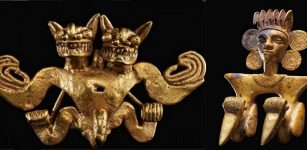 Mysterious Sophisticated Gran Coclé Culture Reveals Its Ancient Secrets
Civilizations | Mar 9, 2020
Mysterious Sophisticated Gran Coclé Culture Reveals Its Ancient Secrets
Civilizations | Mar 9, 2020 -
 Confucius: Philosopher, Educationist And Great Intellect With A Noble Morality
Featured Stories | Jul 27, 2016
Confucius: Philosopher, Educationist And Great Intellect With A Noble Morality
Featured Stories | Jul 27, 2016 -
 Secrets Of Quipu – One Of The Most Mysterious Phenomena That Existed In Odd Number Of Dimensions
Featured Stories | Feb 9, 2015
Secrets Of Quipu – One Of The Most Mysterious Phenomena That Existed In Odd Number Of Dimensions
Featured Stories | Feb 9, 2015 -
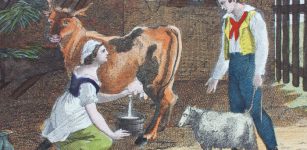 Drinking Milk Increased Ancient Human Body Size – New Study
Archaeology | Jan 18, 2023
Drinking Milk Increased Ancient Human Body Size – New Study
Archaeology | Jan 18, 2023 -
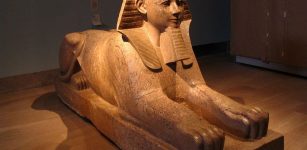 Why Was Pharaoh Hatshepsut’s Reign Virtually Erased From History?
Featured Stories | Nov 9, 2014
Why Was Pharaoh Hatshepsut’s Reign Virtually Erased From History?
Featured Stories | Nov 9, 2014 -
 On This Day In History: King John Of England Died – On Oct 19, 1216
News | Oct 19, 2017
On This Day In History: King John Of England Died – On Oct 19, 1216
News | Oct 19, 2017 -
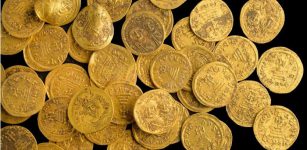 Hidden Byzantine Hoard Offers Evidence Of A Dramatic Historial Event In The Levant
Artifacts | Oct 13, 2022
Hidden Byzantine Hoard Offers Evidence Of A Dramatic Historial Event In The Levant
Artifacts | Oct 13, 2022 -
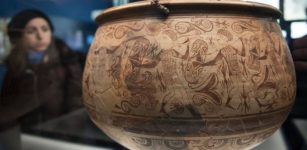 Ancient Secrets Of Iberian Warrior Vase – 2,000-Year-Old Masterpiece Of Art
Archaeology | Dec 5, 2017
Ancient Secrets Of Iberian Warrior Vase – 2,000-Year-Old Masterpiece Of Art
Archaeology | Dec 5, 2017 -
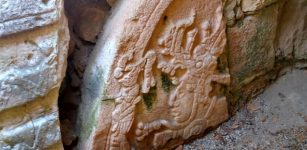 Dzibilchaltún: One Of The Most Ancient Mayan Centers In Northwest Yucatan, Mexico
Civilizations | Feb 2, 2016
Dzibilchaltún: One Of The Most Ancient Mayan Centers In Northwest Yucatan, Mexico
Civilizations | Feb 2, 2016 -
 Amazing ‘Sigiriya’- ‘Lion Rock’ Fortress In Sri Lanka With Frescoes, Mirror Wall And Miniature Gardens
Civilizations | Jan 4, 2019
Amazing ‘Sigiriya’- ‘Lion Rock’ Fortress In Sri Lanka With Frescoes, Mirror Wall And Miniature Gardens
Civilizations | Jan 4, 2019 -
 Skeleton Of An Ancient Roman Mercenary Buried With His Sword Discovered In South Wales
Archaeology | Apr 6, 2022
Skeleton Of An Ancient Roman Mercenary Buried With His Sword Discovered In South Wales
Archaeology | Apr 6, 2022 -
 El Mirador: Ancient Pyramids Hidden In The Lost City Of The Maya
Featured Stories | Aug 1, 2018
El Mirador: Ancient Pyramids Hidden In The Lost City Of The Maya
Featured Stories | Aug 1, 2018 -
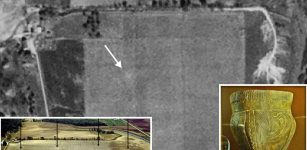 Long-Lost Ancient Burial Mounds Of The Havana Hopewell Culture Re-Discovered In Iowa
Archaeology | Apr 6, 2021
Long-Lost Ancient Burial Mounds Of The Havana Hopewell Culture Re-Discovered In Iowa
Archaeology | Apr 6, 2021 -
 World’s First Recreated Ancient Egyptian Garden Is Now Open To The Public
News | May 17, 2022
World’s First Recreated Ancient Egyptian Garden Is Now Open To The Public
News | May 17, 2022 -
 1,500-Year-Old ‘Magical Mirror’ To Protect Against Evil Eye Discovered By A Teenager In Israel
Archaeology | Aug 9, 2023
1,500-Year-Old ‘Magical Mirror’ To Protect Against Evil Eye Discovered By A Teenager In Israel
Archaeology | Aug 9, 2023 -
 Rare Discovery: Giant Stone Artifacts Found On Ice Age Site In Kent
Archaeology | Jul 6, 2023
Rare Discovery: Giant Stone Artifacts Found On Ice Age Site In Kent
Archaeology | Jul 6, 2023 -
 Mysterious Tiny Pre-Viking Gold Foil Figures Baffle Scientists
Archaeology | Nov 5, 2019
Mysterious Tiny Pre-Viking Gold Foil Figures Baffle Scientists
Archaeology | Nov 5, 2019

